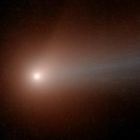C/2014 Q2 (Lovejoy)
 C/2014 Q2 as imaged 19 January 2015[1] | |
| Discovery | |
|---|---|
| Discovered by | Terry Lovejoy 0.2-m Schmidt (Q80)[2] |
| Discovery date | 17 August 2014 |
| Orbital characteristics | |
| Epoch | 18 January 2015[3] |
| Perihelion | 1.29077 AU (q)[3] |
| Eccentricity | 0.99811[3] |
| Orbital period | ~11000 years inbound (Barycentric solution for epoch 1950)[4] ~8000 years outbound (Barycentric solution for epoch 2050)[4] |
| Inclination | 80.301°[3] |
| Last perihelion | 30 January 2015[3] |
C/2014 Q2 (Lovejoy) is a long-period comet discovered on 17 August 2014 by Terry Lovejoy using a 0.2-meter (8 in) Schmidt–Cassegrain telescope.[2] It was discovered at apparent magnitude 15 in the southern constellation of Puppis.[2] It is the fifth comet discovered by Terry Lovejoy. Its blue-green glow is the result of organic molecules and water released by the comet fluorescing under the harsh UV and optical light of the sun as it passes through space.[5][6]
History
By December 2014, the comet had brightened to roughly magnitude 7.4,[7] making it a small telescope and binoculars target. By mid-December, the comet was visible to the naked eye for experienced observers with dark skies and keen eyesight.[8] On 28−29 December 2014, the comet passed 1/3° from globular cluster Messier 79.[9] In January 2015, it brightened to roughly magnitude 4,[10] and became one of the brightest comets located high in a dark sky since comet C/1995 O1 (Hale-Bopp) in 1997. On 7 January 2015, the comet passed 0.469 AU (70,200,000 km; 43,600,000 mi) from Earth.[11] It crossed the celestial equator on 9 January 2015, becoming better seen from the Northern Hemisphere.[12] The comet came to perihelion (closest approach to the Sun) on 30 January 2015, at a distance of 1.29 AU (193,000,000 km; 120,000,000 mi) from the Sun.[3] At perihelion, its water production rate exceeded 20 metric tons per second.[5]
C/2014 Q2 originated from the Oort cloud,[5] but is not a dynamically new comet.[13] Before entering the planetary region (epoch 1950), C/2014 Q2 had an orbital period of about 11,000 years, with an aphelion about 995 AU (1.49×1011 km; 9.25×1010 mi) from the Sun.[4] After leaving the planetary region (epoch 2050), it will have an orbital period of about 8,000 years, with aphelion of about 800 AU.[4]
The comet was observed to release 21 different organic molecules in gas, including ethanol and glycolaldehyde, a simple sugar.[5][14] The presence of organic molecules suggests that they are preserved materials synthesized in the outskirts of the solar nebula or at earlier stages of the Solar System formation.[5]
Gallery
-
C/2014 Q2 glowing green over La Silla Observatory
-
C/2014 Q2 seen passing through Lepus, 29 December 2014
-
C/2014 Q2, 17 January 2015, with an 8" Schmidt–Cassegrain telescope
-
C/2014 Q2 and the Pleiades star cluster, 19 January 2015, with a DSLR
-
C/2014 Q2, 30 January 2015, NEOWISE
References
- ^ "Comet Lovejoy". Sky & Telescope. Retrieved 15 March 2015.
- ^ a b c "MPEC 2014-Q10 : COMET C/2014 Q2 (LOVEJOY)". IAU Minor Planet Center. 19 August 2014. Retrieved 14 September 2014. (CK14Q020)
- ^ a b c d e f "MPEC 2014-R69 : Observations and Orbits of Comets". IAU Minor Planet Center. 7 September 2014. Retrieved 14 September 2014.
- ^ a b c d Horizons output. "Barycentric Osculating Orbital Elements for Comet C/2014 Q2 (Lovejoy)". Retrieved 5 January 2015. (Solution using the Solar System Barycenter and barycentric coordinates. Select Ephemeris Type:Elements and Center:@0)
- ^ a b c d e Biver, Nicolas; Bockelée-Morvan, Dominique; Moreno, Raphaël; Crovisier, Jacques; Colom, Pierre; et al. (23 October 2015). "Ethyl alcohol and sugar in comet C/2014 Q2 (Lovejoy)". Science Advances. 1 (9). e1500863. arXiv:1511.04999. Bibcode:2015SciA....1E0863B. doi:10.1126/sciadv.1500863.
- ^ Plait, Phil (3 January 2015). "Comet Lovejoy, Because Holy Wow". Slate.com. Bad Astronomy. Retrieved 24 October 2015.
- ^ Yoshida, Seiichi (7 December 2014). "Weekly Information about Bright Comets (2014 Dec. 6: South)". aerith.net. Retrieved 9 December 2014.
- ^ Alan MacRobert (15 December 2014). "Binocular Comet Lovejoy Heading Our Way". Sky & Telescope. Retrieved 18 December 2014.
- ^ Bob King (8 December 2014). "C/2014 Q2 Lovejoy – A Binocular Comet in Time for Christmas". Universe Today. Retrieved 9 December 2014.
- ^ Seiichi Yoshida (14 September 2014). "C/2014 Q2 ( Lovejoy )". Seiichi Yoshida's Comet Catalog. Archived from the original on 15 September 2014. Retrieved 2013-09-14.
{{cite web}}: Unknown parameter|deadurl=ignored (|url-status=suggested) (help) - ^ "JPL Close-Approach Data: C/2014 Q2 (Lovejoy)" (last observation: 2014-10-02; arc: 93 days). Retrieved 26 October 2014.
- ^ "Elements and Ephemeris for C/2014 Q2 (Lovejoy)". Minor Planet Center. Retrieved 29 October 2014. (CK14Q020)
- ^ "C/2014 Q2 (Lovejoy) Orbit at the Minor Planet Center". Retrieved 24 October 2015.
- ^ Steigerwald, Bill (23 October 2015). "Researchers Catch Comet Lovejoy Giving Away Alcohol". NASA. Retrieved 24 October 2015.
External links
- Two possible light curves (Alexandre Amorim)
- C/2014 Q2 (Lovejoy) images (Damian Peach)
- C/2014 Q2 (Lovejoy) at CometBase database










